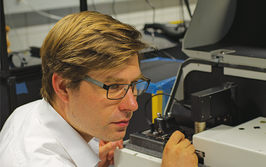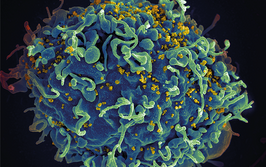Molecularly Imprinted Polymers: The Future of Smart and Sustainable Sensing
Unlocking the potential of synthetic receptors for precise, eco-friendly diagnostics and environmental monitoring – paving the way for next-gen sensor technology
Sibel A. Ozkan | | 4 min read | Opinion

Supplied by Author
In the realm of electrochemical sensors, molecularly imprinted polymers (MIPs) have garnered significant attention for their intriguing integration of synthetic chemistry with sensor technology. These versatile polymers offer clear advantages and present interesting challenges, as they are designed to mimic the specificity of natural receptors. MIP-based electrochemical sensors are highly advantageous due to their specialized structure, which enables precise identification of target molecules. This results in excellent selectivity, comparable to biological receptors, but with greater robustness, stability, and environmental friendliness than other methods.
Molecular imprinting, which remains largely unaffected by physical conditions, paves the way for developing future sensors where artificial receptors can be created. Furthermore, MIPs can be designed to detect a wide range of analytes, from small drugs to large macromolecules, expanding their applications in areas such as food safety, environmental monitoring, and medical diagnostics. Their ability to function in complex matrices without interference enhances their reliability and precision, meeting critical requirements in modern sensor technology.
However, widespread adoption and commercialization of MIPs are not without challenges. The design and synthesis of MIPs can be costly and labor-intensive, requiring careful optimization of polymerization, removal, and rebinding conditions. The complexity of these systems may hinder their scalability and economic feasibility, posing a barrier to their integration into large-scale sensor networks or consumer products. Combining MIP sensors with advanced technologies like artificial intelligence could revolutionize data collection and processing, leading to more dynamic and adaptable sensor networks. This advancement could enable accurate and efficient real-time monitoring of environmental pollutants or rapid medical diagnostics using portable devices equipped with MIP sensors.
Overcoming current obstacles and leveraging their unique advantages will be crucial to fully realize the potential of these artificial, highly selective receptors for innovative applications as research on them continues to evolve. Embracing multidisciplinary approaches and incorporating emerging technologies to achieve this potential is an exciting path for sensor development, offering new opportunities to enhance our ability to harness the significant potential of MIP technology.
To increase the commercial presence of MIPs, advancements in MIP research are expected to bridge the gap between large-scale manufacturing and laboratory-scale production. The application of MIPs to in vitro diagnostics is anticipated to rise due to their low cost, strong binding affinities, and other intelligent characteristics, including magnetic nature, temperature sensitivity, and pH sensitivity. The portfolio of MIPs, currently limited to "model" analytes, will be expanded by growing interest in and discovering other biomarkers for disease detection. Additionally, MIPs are expected to play a significant role in the point-of-care (POC) devices industry by offering multiple molecular tests in a single bedside device, thanks to the multiplexing advantage they provide. The inherent ability of MIPs to imprint any target molecule, regardless of size, opens up a wide range of applications, including the detection of quorum-sensing molecules. Although the development of MIPs for macromolecules such as proteins, including many biomarkers, is still in its infancy, molecular imprinting technology has long been known and commercialized for small molecules.
One of the main obstacles in creating MIPs for biomarkers is the high cost or unavailability of templates. However, a more flexible and cost-effective method for MIP synthesis for biomarkers – essential to the development of in vitro diagnostics – has been made possible by combining epitope imprinting with a computational approach for selecting monomers. The creation of biomimetic MIP films on sensing devices and further solid-phase imprinting holds great promise for advancing in vitro diagnostics technology.
Finally, green chemistry is a key consideration when developing any new technique or process, with a focus on eliminating waste and avoiding toxic or hazardous reagents and solvents. Indeed, tools to assess a method’s environmental friendliness have become a critical component of its overall value, alongside effectiveness, practicality, reliability, and cost-effectiveness. MIPs can be synthesized using harmless or environmentally friendly reagents and techniques, prioritizing user safety and environmental protection. Although most MIPs in the literature are not entirely green, there is steady progress toward synthesizing polymers with environmentally friendly reagents. For example, inorganic reagents are generally less volatile and less toxic compared to the organic chemicals traditionally used in MIP synthesis. However, there remain significant opportunities in molecular imprinting technology to improve the green aspects of synthesis, including the search for greener reagents such as initiators and cross-linking monomers.
In conclusion, innovative designs coupled with new MIP ligands are poised to shape the future of lab-on-a-chip sensing systems. Identifying and incorporating specific biomolecules compatible with microfluidic devices will be crucial. In early-stage medical diagnostics, small, low-cost, and easily handled microchips could have a wide range of applications. As a portable and disposable sensor system, it also shows great promise for point-of-care applications. The ability to analyze low sample volumes with rapid response times offers a significant advantage over conventional methods.
Moving forward, it will be important to focus on methods that consider environmental impact and sustainability, such as developing MIP-based sensors with green profiles, environmentally friendly materials, energy-efficient synthesis, and minimal waste.
Ankara University, Faculty of Pharmacy, Department of Analytical Chemistry, Türkiye


















